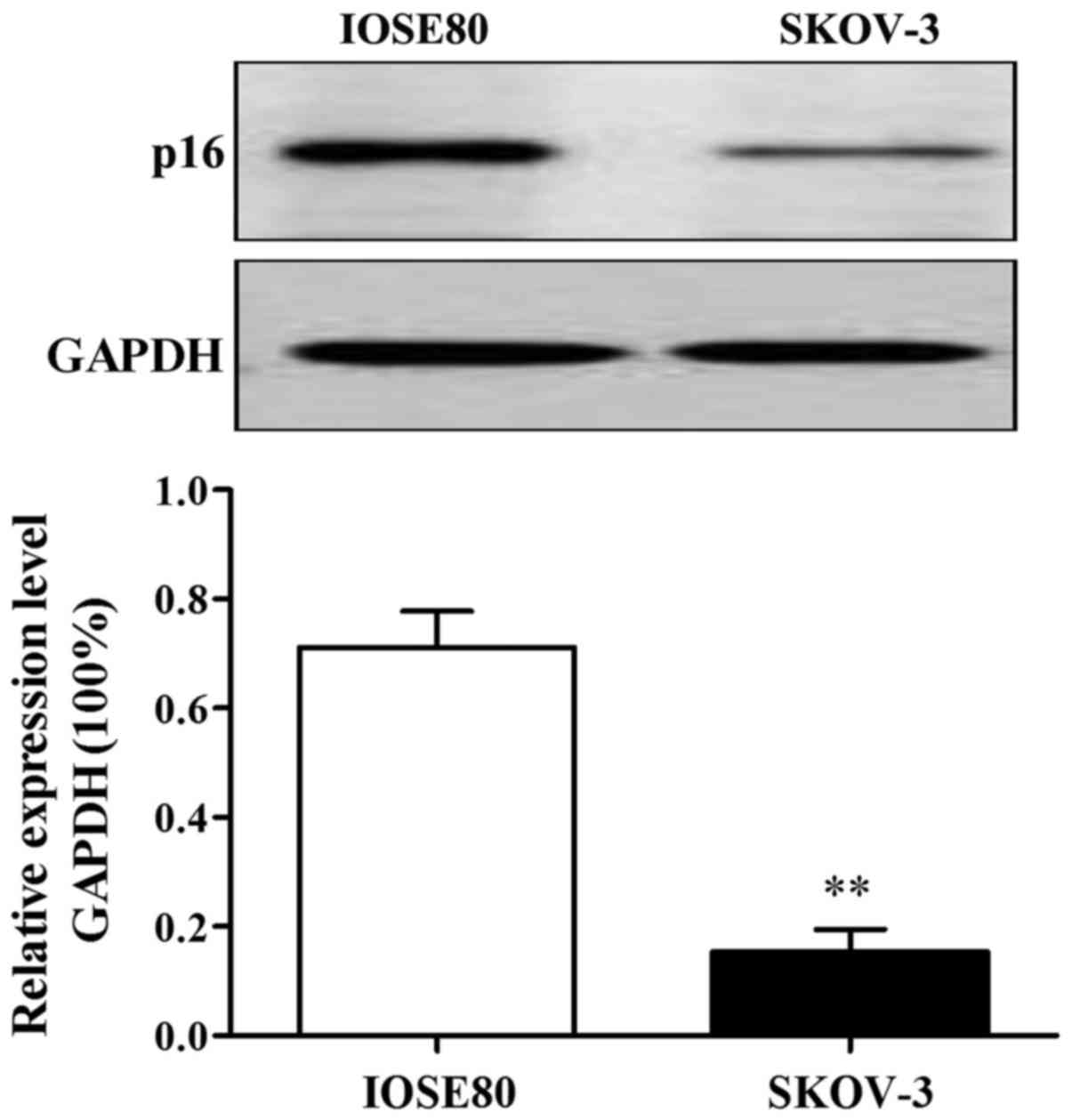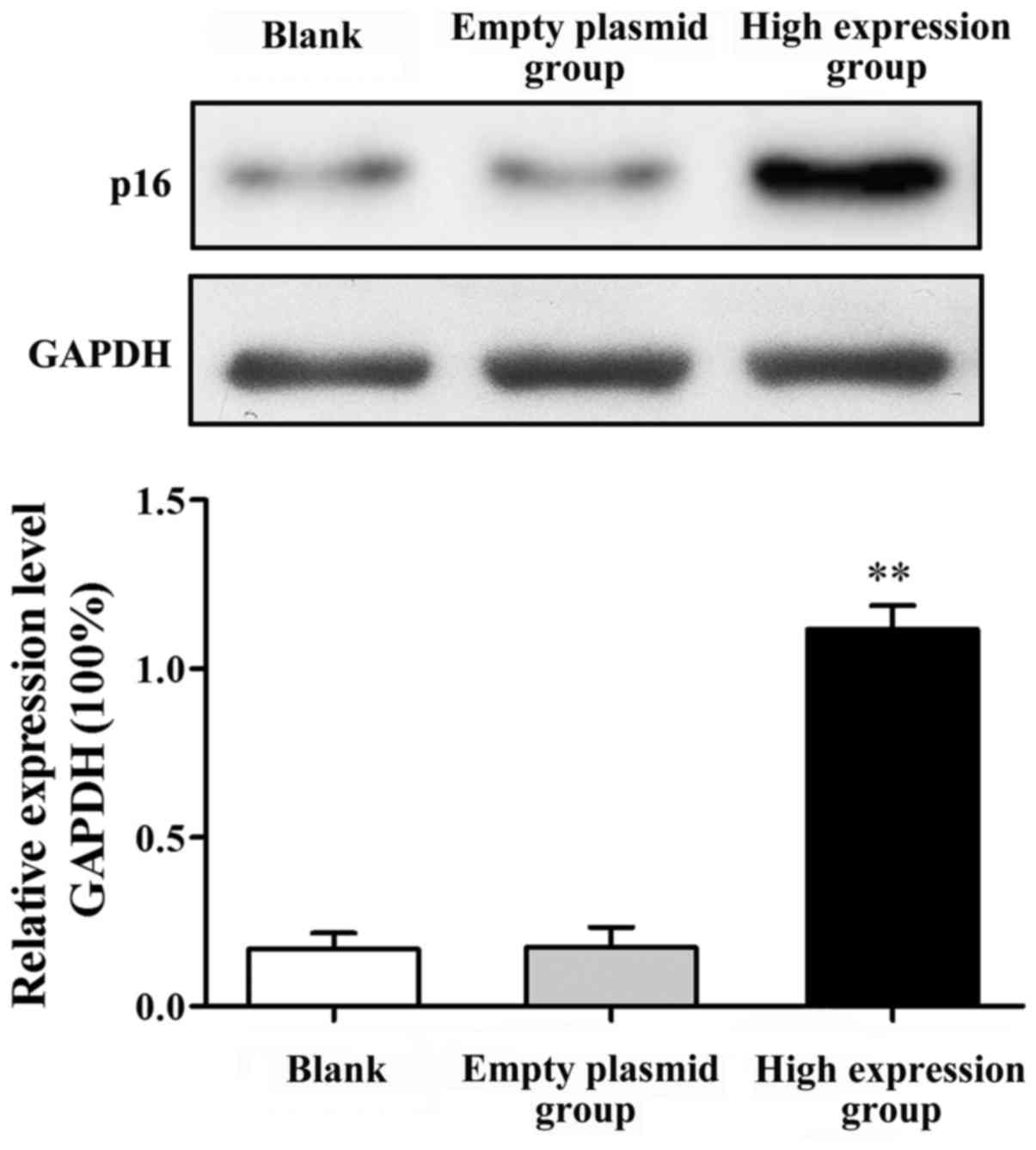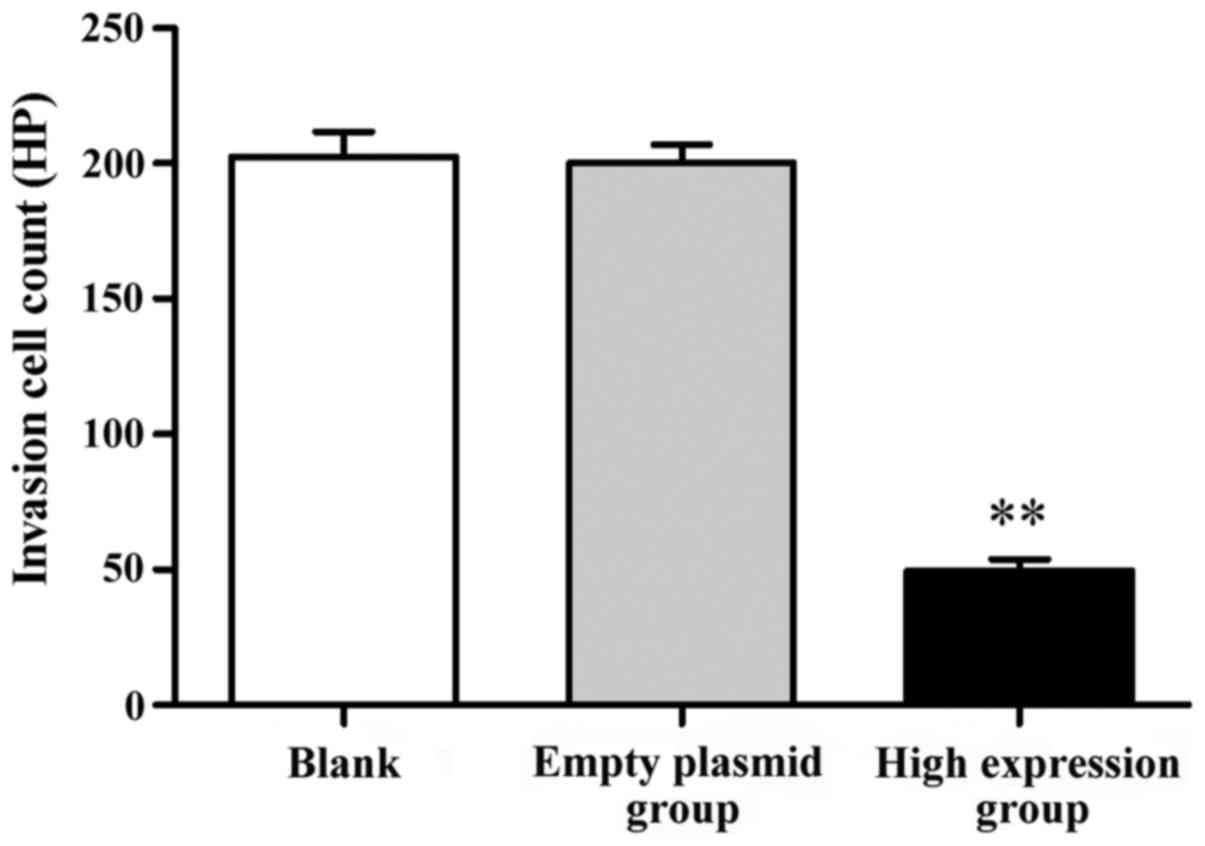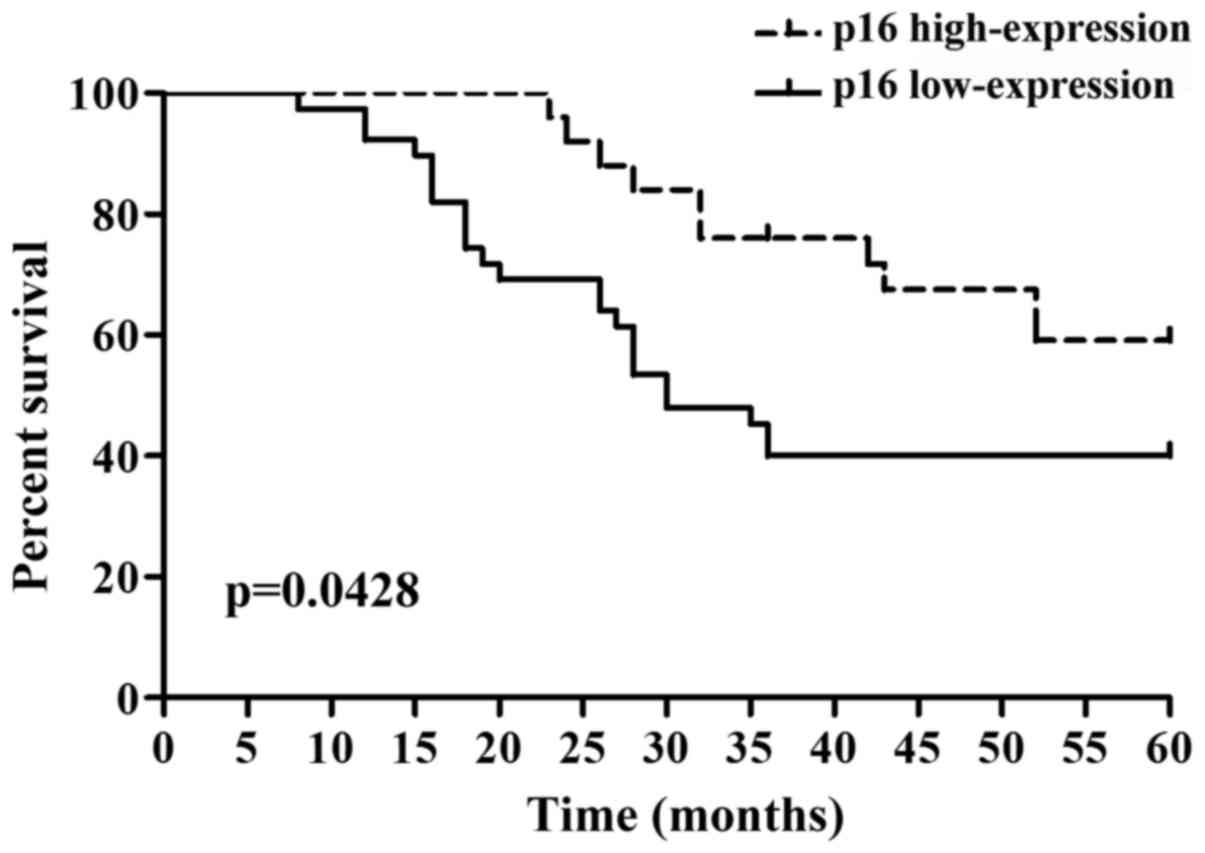Expression of the tumor suppressor gene p16, and lymph node metastasis in patients with ovarian cancer
- Authors:
- Published online on: August 8, 2017 https://doi.org/10.3892/ol.2017.6733
- Pages: 4689-4693
-
Copyright: © Wang et al. This is an open access article distributed under the terms of Creative Commons Attribution License.
Abstract
Introduction
Ovarian cancer is one of the most common malignant tumors in women, ranking third in incidence after cervical and endometrial cancers. Epithelial ovarian cancer is the most common type of ovarian cancer (1,2). Clinical treatment of ovarian cancer mainly consists of surgery combined with chemotherapy. However, over time, cancer cells can develop resistance to chemotherapy, leading to a failure in the efficacy of therapy. At present, the 5-year survival rate of ovarian cancer is low and poses a serious health threat to women (3,4).
Multiple tumor suppressor 1, also known as p16 gene, was found and isolated in 1993 and is regarded as a tumor suppressor gene (5,6). p16 gene is the inhibiting factor of cyclin-dependent kinase 4, which is involved in the regulation of normal cell growth. The deficiency or mutation of p16 gene is closely related to the formation of tumors and poor prognosis of the patient (7–9).
This study compared the expression of p16 protein in ovarian cancer tissue and normal ovarian tissue, and tested the influence of p16 protein expression on the invasion of ovarian cancer cells. In addition, combined with clinical research data, our investigation assessed the correlation between the p16 gene and the lymph node metastasis in human ovarian cancer cases and the patient prognosis.
Materials and methods
Materials
SKOV-3 (ovarian cancer cells) and IOSE80 (normal ovarian cells) were sourced from Cell Bank of the Chinese Academy of Sciences (Beijing, China). TRIzol, the RT-PCR kit and Lipofectamine 2000 were from Invitrogen (Thermo Fisher Scientific, Waltham, MA, USA). Fetal bovine serum (FBS) was from GE Healthcare Life Sciences HyClone Laboratories, Inc. (Logan, UT, USA). p16, rabbit monoclonal GAPDH primary antibody (dilution, 1:500; cat. no. 10494-1-AP) and goat anti-rabbit HRP-labeled secondary antibody (dilution, 1:2,000; cat. no. SA00001-2) were from Wuhan Sanying Biological Technology Co., Ltd. (Wuhan, china). RPMI-1640 medium and a Transwell chamber were from Corning Inc. (New York, NY, USA). Immunohistochemical staining kits (SP-9001) were from Beijing Zhongshan Golden Bridge Biotechnology Co., Ltd. (Beijing, China). pEGFP-N1 was from Clontech Laboratories, Inc. (Mountain View, CA, USA). The primer was synthesized by GenePharma (Shanghai, China).
All patients, as well as tissue samples, in clinical research were selected from the Qilu Hospital of Shandong University. This study was approved by the Ethics Committee of Qilu Hospital. Signed written informed consents were obtained from all participants before the study. There were 20 cases with normal ovarian tissue and 64 cases with ovarian cancer tissue, including 38 cases with lymph node metastasis and 26 cases without lymph node metastasis.
Cell culture
IOSE80 and SKOV-3 cells were cultured at 5% CO2 and 37°C in an incubator, using RPMI-1640 medium (containing 10% FBS). The medium was changed every day, followed by subculture after cell overgrowth.
Detection of p16 protein expression in cells using western blot analysis
IOSE80 and SKOV-3 cells were each cultured and cell lysis buffer was added to extract the total protein. Protein concentration was determined by BCA method, followed by electrophoresis and membrane transfer. It was then sealed by 5% skimmed milk powder, p16 and GAPDH antibody were added, and then it was incubated overnight at 4°C. The following day, it was incubated with HRP-labeled secondary antibody at room temperature for 2 h, followed by photography and film development.
Detection of p16 protein expression in tissues using immunohistochemical techniques
Detection of p16 was carried out according to a protocol, as follows: a paraffin section was dewaxed and 3% H2O2 solution and used to block the endogenous peroxidase, followed by high-pressure antigen repair. It was sealed by 10% goat serum and the primary antibody was added (diluted in the ratio of 1:100), then incubated at 4°C overnight and washed three times using PBS. The biotin-labeled secondary antibody was added and incubated for 30 min, washed three times using PBS, developed using DAB and redyed using hematoxylin. It was then sealed by neutral gum and photographed under a microscope (BX-42; Olympus, Tokyo, Japan).
According to the following scoring standard, the number of positive stained cells was calculated and divided into the p16 low-expression group (the number of positive cells <10%) or the p16 high-expression group (the number of positive cells >10%). The scoring results were then summarized and analyzed.
Construction and transfection of p16 gene high-expression vector
SKOV-3 cells in logarithmic phase were centrifuged after digestion, and collected. The total RNA was extracted using TRIzol, followed by reverse transcription using a reverse transcription kit. Then, the p16 primer was added (Table I) for gene amplification. The reaction conditions were as follows: 94°C for 5 min, degeneration at 94°C for 30 sec, annealing at 63°C for 30 sec, extension at 72°C for 30 sec, amplification for 30 cycles, extension at 72°C for 5 min and termination of the reaction at 4°C. The amplified fragment was then inserted between HindIII and KpnI of pEGFP-N1, constituting the recombinant plasmid, pEGFPN1-p16.
The cells were divided into the normal group, the empty plasmid group and the high-expression group in the transfection experiment. SKOV-3 cells in logarithmic phase were prepared into a single-cell suspension liquid using trypsin digestion. The cells were cultured using 6-well plates. After adherence, a p16 gene high-expression vector was used by Lipofectamine 2000 to transfect the SKOV-3 cells in strict accordance with the protocol.
Influence of the transfection of p16 gene on the expression and cell invasion ability of p16 protein
At 48 h after transfection, according to the above method, the expression of p53 protein in the cells of each group was detected using the method as identified earlier. A Transwell chamber was used to prepare the cells at 48 h after transfection into a single-cell suspension liquid, according to the protocol. A total of 100 µl single-cell suspension liquid at the concentration of 4×105/ml and 100 µl serum-free medium were added to the upper chamber and 500 µl medium containing 30% FBS was added to the lower chamber. After 48 h, it was fixed, dyed and analyzed.
Correlation between p16 expression in ovarian cancer and prognosis
The patients were divided into the p16 low-expression group and the p16 high-expression group. There were no statistically significant differences in the gender, age, smoking history, drinking history and family history between the two groups (P>0.05). The 5-year survival rate was then calculated. Based on the results of the follow-up visit, the influence of p16 expression on the prognosis of patients with ovarian cancer was determined.
Statistical analysis
SPSS 16.0 software (SPSS, Inc., Chicago, IL, USA) was used for all analyses in the study. One-way ANOVA and Kaplan-Meier survival analysis were used for the clinical prognosis results. P<0.05 suggested that the difference was statistically significant.
Results
p16 protein expression in IOSE80 and SKOV-3
The results of western blot analysis showed that p16 protein expression in SKOV-3 was lower than that in IOSE80 and the difference was statistically significant (P<0.01) (Fig. 1).
p16 protein expression in ovarian cancer tissue
Immunohistochemical results showed that p16 protein was stained brownish, with the normal ovarian tissue and p16 high-expression tumor tissue stained with deep brown color. The positive cells occupied a larger proportion than the normal cells, as shown in Fig. 2. There were 25 cases with p16 high expression (positive) (39.06%) among the 64 cases with ovarian cancer, and 14 cases with p16 high expression (positive) (70.00%) among the normal tissue, and the differences between the two groups were statistically significant (P<0.01) (Table II). The expression of p16 protein was associated with lymph node metastasis in ovarian cancer, and the positive expression rate of p16 protein in the tissue of ovarian cancer patients with lymph node metastasis was significantly lower than that without lymph node metastasis (P<0.01) (Table III).
Influence of p16 gene transfection on p16 protein expression
After SKOV-3 cell transfection, western blot analysis was used to demonstrate p16 protein expression (Fig. 3). The p16 protein expression in the high-expression group was significantly increased compared with that in the blank group (P<0.01). p16 protein expression had no significant difference between the blank group and the empty plasmid group (P>0.05).
Influence of p16 gene transfection on SKOV-3 cell invasion ability
The results showed that, after the transfection of SKOV-3 cells by the p16 gene, the number of crossing cells was significantly increased in the high-expression group compared with that in the blank group, and the difference was statistically significant (P<0.01). There was no statistically significant difference between the blank group and the empty plasmid group, indicating that p16 high expression could restrain the SKOV-3 cell invasion ability (Fig. 4).
p16 expression and prognosis in ovarian cancer
There were 39 cases of p16 low-expression with 23 cases of death and 25 cases of p16 high-expression with 10 cases of death among a total of 64 patients with ovarian cancer in the follow-up visit (Table IV). Kaplan-Meier single-factor analysis showed that the expression of p16 had a significant effect on the prognosis of patients (P<0.05) (Fig. 5).
Discussion
Ovarian cancer is one of the three most common malignant tumors of the female reproductive system. Despite advancements in clinical treatment options for ovarian cancer, the persisting poor prognosis of patients underscores the need for further improvements (10).
p16 is one of the members of the INK family, which plays a role in regulating the cell cycle, inhibiting tumor proliferation and promoting apoptosis in cells (11). Research has shown that the mutation rate of p16 gene is 29% in ovarian cancer cells and 15–30% in ovarian cancer tissue (12,13). p16 is known to undergo mutation, gene deletion and methylation in many tumors, thereby losing its normal function (14–17). It has been found that p16 can inhibit the expression of VEGF, thereby inhibiting tumor cell metastasis (18,19). Other studies have confirmed that low p16 protein expression is associated with a negative prognosis for cancer cases (20).
The results of this study demonstrated that the levels of p16 protein expression were decreased in SKOV-3 cells, ovarian cancer tissues and ovarian cancer tissue with lymph node metastasis. In order to further study the role of p16 protein, gene transfection technology was used to increase the expression of p16 protein in SKOV-3 cells, and the results showed that the high p16 protein expression could significantly inhibit the SKOV-3 cells invasion ability. Correlation analysis of survival prognosis showed that lower p16 expression was negatively correlated with the prognosis of patients with ovarian cancer. These results suggest that p16 protein can be used as a new therapeutic target and predictor of prognosis of patients with ovarian cancer.
Acknowledgements
The present study was supported by the National Natural Science Foundation of China (no. 81502238) and the Key Research and Development Projects in Shandong Province, China (no. 2016GSF201150).
References
|
Poveda Velasco A, Casado Herráez A, Ruipérez Cervantes A, Rincón Gallardo D, García García E, Martín González A, García López G, Fernández Mendiola C and González Ojeda B: GEICO Group: Treatment guidelines in ovarian cancer. Clin Transl Oncol. 9:308–316. 2007. View Article : Google Scholar : PubMed/NCBI | |
|
Jemal A, Bray F, Center MM, Ferlay J, Ward E and Forman D: Global cancer statistics. CA Cancer J Clin. 61:69–90. 2011. View Article : Google Scholar : PubMed/NCBI | |
|
Haupt Y, Bath ML, Harris AW and Adams JM: bmi-1 transgene induces lymphomas and collaborates with myc in tumorigenesis. Oncogene. 8:3161–3164. 1993.PubMed/NCBI | |
|
Bhattacharyya J, Mihara K, Ohtsubo M, Yasunaga S, Takei Y, Yanagihara K, Sakai A, Hoshi M, Takihara Y and Kimura A: Overexpression of BMI-1 correlates with drug resistance in B-cell lymphoma cells through the stabilization of survivin expression. Cancer Sci. 103:34–41. 2012. View Article : Google Scholar : PubMed/NCBI | |
|
Serrano M, Hannon GJ and Beach D: A new regulatory motif in cell-cycle control causing specific inhibition of cyclin D/CDK4. Nature. 366:704–707. 1993. View Article : Google Scholar : PubMed/NCBI | |
|
Al-Khalaf HH and Aboussekhra A: P16INK4A positively regulates p21WAF1 expression by suppressing AUF1-dependent mRNA decay. PLoS One. 8:e701332013. View Article : Google Scholar : PubMed/NCBI | |
|
Marx J: New tumor suppressor may rival p53. Science. 264:344–345. 1994. View Article : Google Scholar : PubMed/NCBI | |
|
Kamb A, Gruis NA, Weaver-Feldhaus J, Liu Q, Harshman K, Tavtigian SV, Stockert E, Day RS 3rd, Johnson BE and Skolnick MH: A cell cycle regulator potentially involved in genesis of many tumor types. Science. 264:436–440. 1994. View Article : Google Scholar : PubMed/NCBI | |
|
Chang Z, Ju H, Ling J, Zhuang Z, Li Z, Wang H, Fleming JB, Freeman JW, Yu D, Huang P, et al: Cooperativity of oncogenic K-ras and downregulated p16/INK4A in human pancreatic tumorigenesis. PLoS One. 9:e1014522014. View Article : Google Scholar : PubMed/NCBI | |
|
Katsumata N: Dose-dense approaches to ovarian cancer treatment. Curr Treat Options Oncol. 16:212015. View Article : Google Scholar : PubMed/NCBI | |
|
Naqshe Zahra S, Khattak NA and Mir A: Comparative modeling and docking studies of p16ink4/Cyclin D1/Rb pathway genes in lung cancer revealed functionally interactive residue of RB1 and its functional partner E2F1. Theor Biol Med Model. 10:12013. View Article : Google Scholar : PubMed/NCBI | |
|
Kanuma T, Nishida J, Gima T, Barrett JC and Wake N: Alterations of the p16INK4A gene in human ovarian cancers. Mol Carcinog. 18:134–141. 1997. View Article : Google Scholar : PubMed/NCBI | |
|
Schuyer M, van Staveren IL, Klijn JG, vd Burg ME, Stoter G, Henzen-Logmans SC, Foekens JA and Berns EM: Sporadic CDKN2 (MTS1/p16ink4) gene alterations in human ovarian tumours. Br J Cancer. 74:1069–1073. 1996. View Article : Google Scholar : PubMed/NCBI | |
|
Jha AK, Nikbakht M, Jain V, Capalash N and Kaur J: p16INK4a and p15INK4b gene promoter methylation in cervical cancer patients. Oncol Lett. 3:1331–1335. 2012.PubMed/NCBI | |
|
Ko E, Kim Y, Kim SJ, Joh JW, Song S, Park CK, Park J and Kim DH: Promoter hypermethylation of the p16 gene is associated with poor prognosis in recurrent early-stage hepatocellular carcinoma. Cancer Epidemiol Biomarkers Prev. 17:2260–2267. 2008. View Article : Google Scholar : PubMed/NCBI | |
|
Li G, Ji Y, Liu C, Li J and Zhou Y: Reduced levels of p15INK4b, p16INK4a, p21cip1 and p27kip1 in pancreatic carcinoma. Mol Med Rep. 5:1106–1110. 2012. View Article : Google Scholar : PubMed/NCBI | |
|
Bai P, Xiao X, Zou J, Cui L, Bui Nguyen TM, Liu J, Xiao J, Chang B, Wu J and Wang H: Expression of p14ARF, p15INK4b, p16INK4a and skp2 increases during esophageal squamous cell cancer progression. Exp Ther Med. 3:1026–1032. 2012. View Article : Google Scholar : PubMed/NCBI | |
|
Takeuchi H, Ozawa S, Shih CH, Ando N, Kitagawa Y, Ueda M and Kitajima M: Loss of p16INK4a expression is associated with vascular endothelial growth factor expression in squamous cell carcinoma of the esophagus. Int J Cancer. 109:483–490. 2004. View Article : Google Scholar : PubMed/NCBI | |
|
Al-Ansari MM, Hendrayani SF, Tulbah A, Al-Tweigeri T, Shehata AI and Aboussekhra A: p16INK4A represses breast stromal fibroblasts migration/invasion and their VEGF-A-dependent promotion of angiogenesis through Akt inhibition. Neoplasia. 14:1269–1277. 2012. View Article : Google Scholar : PubMed/NCBI | |
|
Surowiak P, Materna V, Maciejczyk A, Pudelko M, Suchocki S, Kedzia W, Nowak-Markwitz E, Dumanska M, Spaczynski M, Zabel M, et al: Decreased expression of p16 in ovarian cancers represents an unfavourable prognostic factor. Histol Histopathol. 23:531–538. 2008.PubMed/NCBI |














